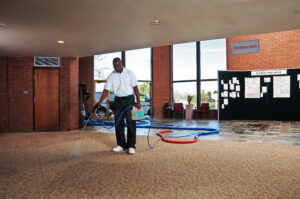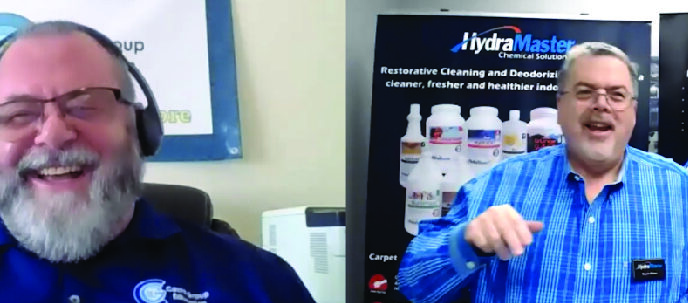What is wrong with the fogging and or electrostatic spraying a disinfectant as a sole response/treatment to COVID-19?
In any application of sanitization and disinfection, the first step must first be deep, restorative cleaning, extraction, and removal of unwanted substances. For surfaces that can be treated with chemical sanitizers and disinfectants, removal, and extraction of as much of the harmful contamination prior to the application of those disinfectants is extremely important.
During this time of pandemic, many cleaning and restoration companies are being asked to, or are tempted to sell “fogging a disinfectant service” as a sole treatment step in making an indoor environment safer. We will never stop the “fogging and miracle cure” crowd during the time of a pandemic, any more than we can stop untrained carpet cleaners extracting grey or black water after massive flooding with a portable extractor and box fans they bought for $13 at Walmart, When the demand exceeds the supply, the snake oil salesman will always show up. However, it would be nice for organizations, rather than just individuals to be “louder” in talking about the truth. There ultimately is HUGE value in applying disinfectants – even if it just mainly brings “peace of mind” There is nothing to lose here for our industry by promoting the truth
I guess the most perplexing part of all of this to me as to why people keep asking the same questions over and over again about fogging a disinfectant is this: The EPA is being asked the same questions that are being asked of “experts” in the cleaning and restoration industry. They are answering them with virtually the same answers as those in our industry who understand this would, with the caveat they (EPA) understand they are writing for a wider audience with varied levels of education and comprehension. Here are some examples:
In 2013, the EPA sent a letter to all the companies who had approved and registered disinfectants addressing their concern about the measured effectiveness of fogging a disinfectant. Part of the letter stated:
“The reasons that the EPA believes that fogging/misting methods of application may not be adequately effective include the following:
- Application by fogging/misting results in much smaller particle sizes, different surface coverage characteristics, and potentially reduced efficacy when compared to sanitization or disinfection product applications by spraying, sponging, wiping, or mopping
- The absence of pre-cleaning in the presence of soil contamination, potential reaction with or absorption of the active ingredient for different surfaces, and humidity/temperature fluctuations can also impact distribution and efficacy of the product.
- A surface treated by fogging/misting does not receive the same amount of active ingredient per unit area as the standard methods of application and, as a result, the level of efficacy actually achieved may not be the same level claimed on the label.”
Source: https://www.epa.gov/sites/production/files/2015-09/documents/fogger-mister-final-signed-letter.pdf
On the EPA website, they have a frequently asked question section. Several of the questions they answer are related to fogging or electrostatic spraying a disinfectant.
Can I use fumigation or wide-area spraying to help control COVID-19?
· Unless the pesticide product label specifically includes disinfection directions for fogging, fumigation, or wide-area or electrostatic spraying, EPA does not recommend using these methods to apply disinfectants. EPA has not evaluated the product’s safety and efficacy for methods not addressed on the label.
- A disinfectant product’s safety and effectiveness may change based on how you use it. If a pesticide product’s label does not include disinfection directions for use with fogging, fumigation, wide-area, or electrostatic spraying, EPA has not reviewed any data on whether the product is safe and effective when used by those methods.
- The Centers for Disease Control and Prevention (CDC) recommends that you clean contaminated surfaces with liquid disinfectant products to prevent the spread of disease.
Source: https://www.epa.gov/coronavirus/can-i-use-fumigation-or-wide-area-spraying-help-control-covid-19
Many EPA registered disinfectants on the COVID-19 “N” List do not include directions and/or have not been tested for use in fogging. The EPA addressed this issue too:
Can I apply a product using a method that is not specified in the directions for use?
- Any time you use an EPA-registered disinfectant, you should read the product label and follow the directions, including the method of application. This is the best way to ensure the product will safely kill pathogens that cause human illness.
- A disinfectant product’s safety and effectiveness may change based on how you use it. If a disinfectant product’s label does not include disinfection directions for a certain method of application, EPA has not reviewed any data on whether the product is safe and effective when used in this way.
- EPA’s regulatory process ensures that all registered disinfectant products legally sold in the United States include directions for use which, if followed, will allow a product to carry out its intended function without resulting in unreasonable adverse effects on the environment.
- Before using a product, always read its label and follow its instructions, including the application method.
Source: https://www.epa.gov/coronavirus/can-i-apply-product-using-method-not-specified-directions-use
Finally, heath experts who understand the potential pitfalls of widespread use of fogging disinfectants are beginning to speak up. An article published by the CTV Television Network in Canada written by Brooklyn Neustaeter quotes an email they received from Thomas Tenkate, director of Ryerson’s School of Occupational and Public Health. In her article, Ms. Neustaeter points out that “there is no evidence to suggest that misting sanitizer into the air is effective against the COVID-19 virus.” The article quotes from Professor Tenkate’s email: “Getting the disinfectant onto the right surfaces, surfaces which people are likely to touch a lot, in the correct concentration to kill the organism, and in a way that doesn’t cause additional safety risks to workers or the public can be challenging,”
.Industry IICRC instructor and consultant and Aramsco associate Rachel Adams-Beja has written.
“Regardless of what chemicals may be able to destroy the Novel Coronavirus, most efficacy tests are done in clinical environments and not tested “in field” meaning that the real-world application and efficacy may not achieve the same results. As such, it is critical to remember that most antimicrobial products (disinfectants) are not going to achieve the desired results when applied to soiled surfaces, soft furnishings, etc.
Even surfaces that appear visibly clean must be cleaned thoroughly prior to application of chemicals. The fact is that proper cleaning of surfaces is much like washing of hands and offers more protection than application of hand sanitizer as it removes the contamination rather than trying to “kill” or destroy it. The international restoration industry should lead by example and not engage in ineffective practices of applying chemicals (spraying or fogging) without proper cleaning first.”
Yet the “fog the world” crowd seems to be the ones who get most of the press coverage about attacking the pandemic aggressively. The media that covers this stuff mostly does general society a great disservice by not digging into this more with readily available resources like the EPA. But then what else is new with the media not doing their job of a fair investigation?
 In my opinion fogging or electrostatic spraying a disinfectant is not a deep cleaning step. Is there enough “cleaning capacity” in many disinfectants to “help” clean? Certainly. But as the Cleaning Industry Research Institute scientists taught us in their training webinar early on in the response to this pandemic, the virus is often encased within other materials – mainly body fluids and whatever else someone may have had on their hands.
In my opinion fogging or electrostatic spraying a disinfectant is not a deep cleaning step. Is there enough “cleaning capacity” in many disinfectants to “help” clean? Certainly. But as the Cleaning Industry Research Institute scientists taught us in their training webinar early on in the response to this pandemic, the virus is often encased within other materials – mainly body fluids and whatever else someone may have had on their hands.
Inevitably, we finish where we started – the first step to maintaining a healthier indoor environment is to deep clean. This must include a commitment to deep clean on a more frequent basis.
So where does fogging or electrostatic spraying an EPA registered disinfectant fit in? When an EPA registered disinfectant is applied in a controlled environment, specifically according to label directions, it can make an important contribution to maintaining a healthier indoor environment and potentially contribute to the inactivation of the COVID-19 virus and other harmful microorganisms. Perhaps the most important contribution, even considering the EPA’s concerns about effectiveness lies in the visual reinforcement. Fogging as an ADDITIONAL step beyond deep cleaning, and directly applying a disinfectant to all common “touch points” may provide a higher level of “peace of mind” and confidence of the people who are going to live/work/shop in the home or building being treated.
Tags: covid-19, disinfect, electrostatic, epa, fog, fogging, fumigate, fumigation, spray, spraying





